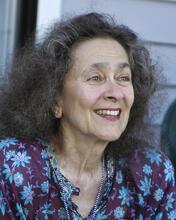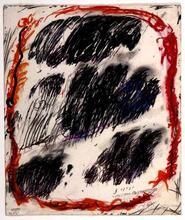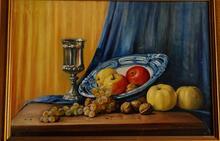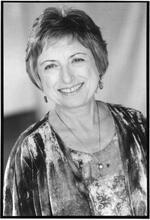Doris Barsky Kreindler
Doris Barsky Kreindler’s use of palette knives to scrape and carve thick paint on her canvasses gave her paintings a sculptural quality and physical presence not usually associated with women’s art. She had her first solo show at the Brooklyn Museum in 1935 but took fourteen years to get another show in the New York area. Undiscouraged, she used the time to travel extensively, an experience that would later fuel her abstract impressionist landscapes. Her 1964 painting Skyscraper hangs in the National Museum of American Art, and other pieces are in the collections of the Metropolitan Museum of Art, the Brooklyn Museum of Art, the Art Institute of Chicago, and the Tel Aviv Museum of Art, among many others.
Vigorous, rapid, and exciting use of the palette knife is not usually associated with women painters in any era, but Doris Barsky Kreindler’s abstract expressionist works in the 1950s, 1960s, and early 1970s, inspired by Hans Hofmann, were exceptional. Abstract expressionism is the art of gesture and movement associated primarily with male artists in the period immediately following World War II. Her 1964 oil painting, Skyscraper, in the National Museum of American Art demonstrates her transition from still lifes of vases of flowers to large-scale (48 inches by 38 1/4 inches [122 cm x 97 cm]) abstractions taken from the landscape of her native New York City.
Family & Education
Doris Barsky was born on August 12, 1901, in Passaic, New Jersey, to Jacob Barsky, a furniture maker, and Rebecca (Levitch) Barsky, a homemaker. The Barskys, Jewish immigrants from Russia, arrived in the United States in 1893. Doris had one older sister, Pauline, and two younger sisters, Mildred and Bernice.
She was educated at the New York School of Applied Design for Women, the National Academy of Design, and the Art Students League in New York City. She also studied with Hans Hofmann.
Doris Barsky married Harry E. Kreindler on February 12, 1920, in Brooklyn. Harry Kreindler was an attorney who founded the firm of Kreindler and Kreindler, originally of Brooklyn and later of New York City. The Kreindlers had two children: Lee Stanley (1924 - 2003), who was a lawyer with Kreindler and Kreindler, and Rosamond Kreindler Koffman born (1928 - 2018), who was a retired teacher of language arts.
Early Work & Inspiration
Kreindler’s first solo exhibition was held at the Brooklyn Museum in 1935. For a period of about fourteen years, none of her works were exhibited in the New York City area and she took the time to travel widely. These travels became the basis for her later exhibitions, which featured abstract landscapes that were inspired by specific locations but contained the universal essence of many outdoor experiences. Her strong, rapid, brightly colored brushstrokes animated the regions that she depicted. Reviews in journals of the time praised her work for its vigor and liveliness—praise usually reserved for male abstract expressionists. She achieved this effect through the thick application of color in diagonal strokes on her atmospheric canvases.
In addition to oils, Kreindler worked in watercolor, lithography, woodblock, engraving, etching, and casein (a sticky, thick paint made from the whey derived from skim milk mixed with color).
Legacy
Kreindler belonged to the American Society of Contemporary Artists, National Association of Women Artists, Artist’s Equity, National Association of Painters in Casein, Society of American Graphics, Alabama Water-Color Society, and The New York Society of Women Artists. Her work is in many national and regional museums, including the Rose Art Museum of Brandeis University, Metropolitan Museum of Art, Museum of Modern Art, Fogg Museum of Art, Brooklyn Museum of Art, Philadelphia Museum of Art, the Art Institute of Chicago, and the Tel Aviv Museum of Art.
Doris Barsky Kreindler died in May 1974 in Florida while on vacation.
Collins, J.L. Women Artists in America: Eighteenth Century to the Present. J.L Collins, 1973.
“Exhibition at Esther Robles Gallery, Los Angeles.” Art News 56 (January 1958): 51.
“Exhibition at Pulitzer.” Art News 58 (March 1959): 57.
“Exhibition at Seligmann Gallery.” Art News 68 (January 1970): 62.
“Exhibition at Seligmann’s.” Art News 50 (January 1952): 46.
“Exhibition of Abstract Landscapes at Seligmann.” Art Digest 29 (February 15, 1954): 26.
“Exhibition of Paintings: Seligmann Gallery.” Art Digest 26 (January 15, 1951): 20+.
Gilbert, Dorothy B., ed. Who’s Who in American Art. New York: R.R. Bowker, 1973.
Havlice, Patricia Pate. Index to Artistic Biography. Vol. 2. Metuchen: Scarecrow Press, 1973.
McNeil, Barbara, ed. Artists Biographies: Master Index. Detroit: Gale Research Co., 1986.
National Museum of American Art. Descriptive Catalogue of Painting and Sculpture in the National Museum of American Art. Boston: G.K. Hall, 1983).
Obituary. NYTimes, May 4, 1974, 44:5.
“Seligmann Gallery, New York: Exhibition.” Art News 72 (February 1973): 83.
“Show at Seligmann Gallery.” Art News 65 (February 1967): 16.
“Show of Paintings and Drawings at Seligmann.” Art News 52 (February 1954): 47.
“Showing at Pulitzer.” Arts 33 (April 1959): 48.
WWIAJ (1938).











